Copyright Disclaimer
No part of this work may be reproduced, distributed, or transmitted in any form or by any means, including photocopying, recording, or other electronic or mechanical methods, without the prior written permission of the copyright holder. For copyright permission requests, please contact pharmacyel@usask.ca.
New for 2024-2025
Updated February 2025
Background information on this page has been updated to reflect the new NAPRA Professional Competencies for Pharmacists and Pharmacy Technicians at Entry to Practice in Canada. In October 2024, the NAPRA competencies were restructured into five domains. Consistent with the NAPRA Model Standards of Practice (2022) that preceded the updated competencies, the IPPE and APPE evaluation form had already been proactively organized into these five domains when it was redesigned in 2023.
Updated February 2024
Effective May 1, 2024, students and preceptors will complete midpoint and final rotations on the following days during IPPE and APPE rotations.
| Midpoint | Student Self-Evaluation Due | Preceptor Evaluation Due |
| IPPE | Tuesday of Week 2 | Thursday of Week 2 |
| APPE | Tuesday of Week 4 | Thursday of Week 4 |
| Final | Student Self-Evaluation Due | Preceptor Evaluation Due |
| IPPE | Wednesday of Week 4 | Friday of Week 4 |
| APPE | Wednesday of Week 8 | Friday of Week 8 |
Rationale: The midpoint evaluation has been shifted to one day earlier from previous years to accommodate the new APPE Reflective Day on Friday of Week 4. While there is no reflective day in IPPE rotations, the evaluation due dates were also shifted in these rotations for consistency for preceptors of both IPPE and APPE rotations.
Context
The information presented on this page is specific to the assessment framework and evaluation strategy used in IPPE and APPE rotations. While the evaluation form is the same, the minimum expected level of achievement required to pass the course increases each year.
Please note this assessment framework does not apply to PHAR 189 Service Learning, PHAR 188 and PHAR 288 immersion courses, nor the PHAR 388 Professional Practice Project. Information about assessment and evaluation in those courses is covered for preceptors in the course-specific Placement Modules in the USask PharmD Preceptor Training and Development Program, and for students in their course orientation presentations and in CORE.
Background
Association of Faculties of Pharmacy of Canada (AFPC) Educational Outcomes
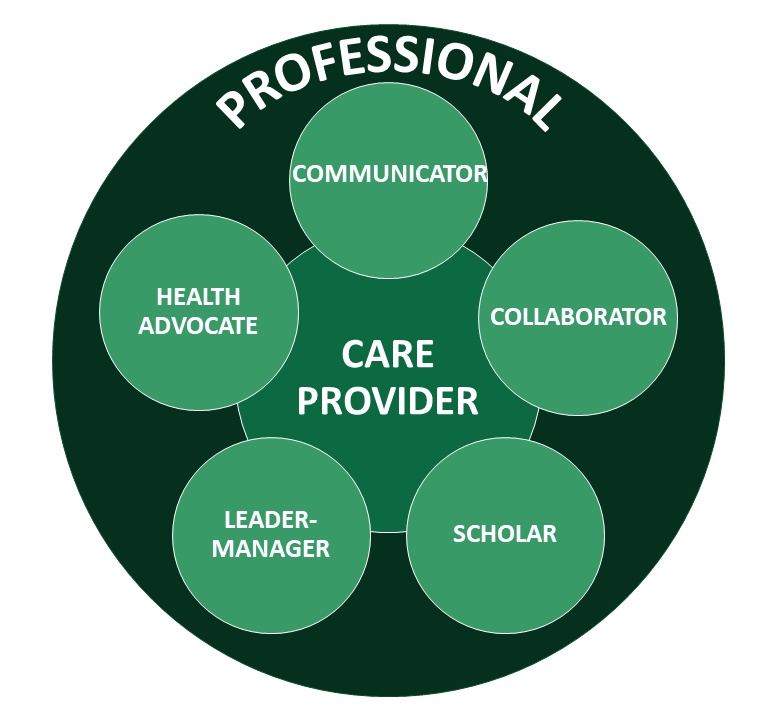
Experiential Learning presents students the opportunity to practice and receive feedback on the essential knowledge, skills, and behaviours of a competent pharmacy professional at entry-to-practice.
The Association of Faculties of Pharmacy of Canada (AFPC) requires pharmacy graduates to demonstrate competence in knowledge and skills in seven overarching Educational Outcomes by the end of the PharmD program:
- Care Provider
- Communicator
- Collaborator
- Scholar
- Health Advocate
- Leader-Manager
- Professional
It is expected that students skillfully integrate elements of the Communicator, Collaborator, Scholar, Leader-Manager, and Health Advocate Educational Outcomes into their role as a Care Provider. The Professional role is the overarching ethos of the discipline of pharmacy and should be consistently and globally demonstrated by students.
National Association of Pharmacy Regulatory Authorities (NAPRA) Competencies
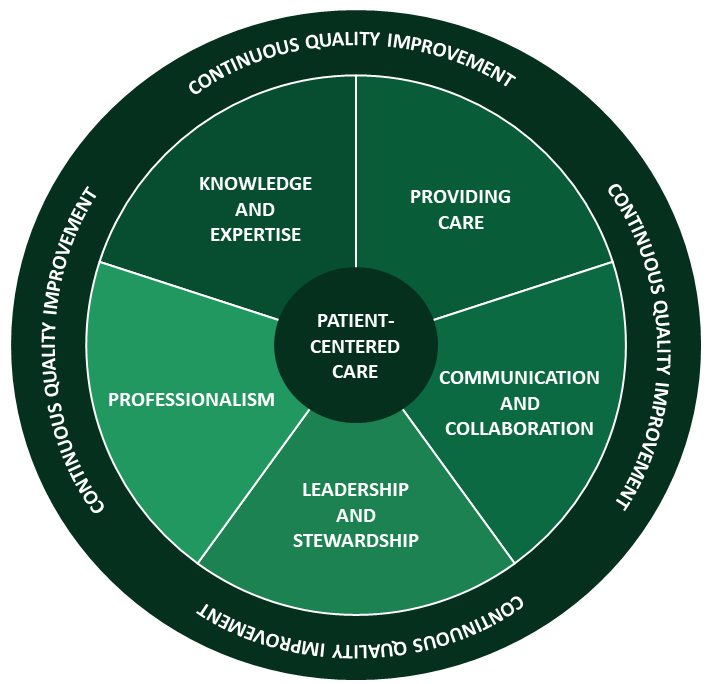
Pharmacy graduates must also demonstrate competence within the five domains outlined in the National Association of Pharmacy Regulatory Authorities (NAPRA) Professional Competencies for Pharmacists and Pharmacy Technicians at Entry to Practice in Canada:
- Providing Care
- Knowledge and Expertise
- Communication and Collaboration
- Leadership and Stewardship
- Professionalism
While the competencies provide an overview of what a pharmacist at entry to practice is expected to be able to do, the NAPRA Model Standards of Practice for Pharmacists and Pharmacy Technicians in Canada outline how a pharmacy professional should perform related tasks. These five domains are contextualized within the concepts of patient-centred care and continuous quality improvement.
Domains and Competencies
USask PharmD EL Domains
The Midpoint and Final Evaluation Form is divided into the five domains of the NAPRA Professional Competencies and Model Standards of Practice documents. Pharmacy professionals should recognize that they demonstrate knowledge, skills, and attitudes within each of these categories every day, and should therefore be able to evaluate them in students.
USask PharmD EL Competencies
Under each domain, USask EL competencies specify the knowledge and skills that must be assessed in the rotation. There are 19 in total, as outlined in the graphics below. All 19 USask EL competencies must be assessed in each direct patient care rotation.
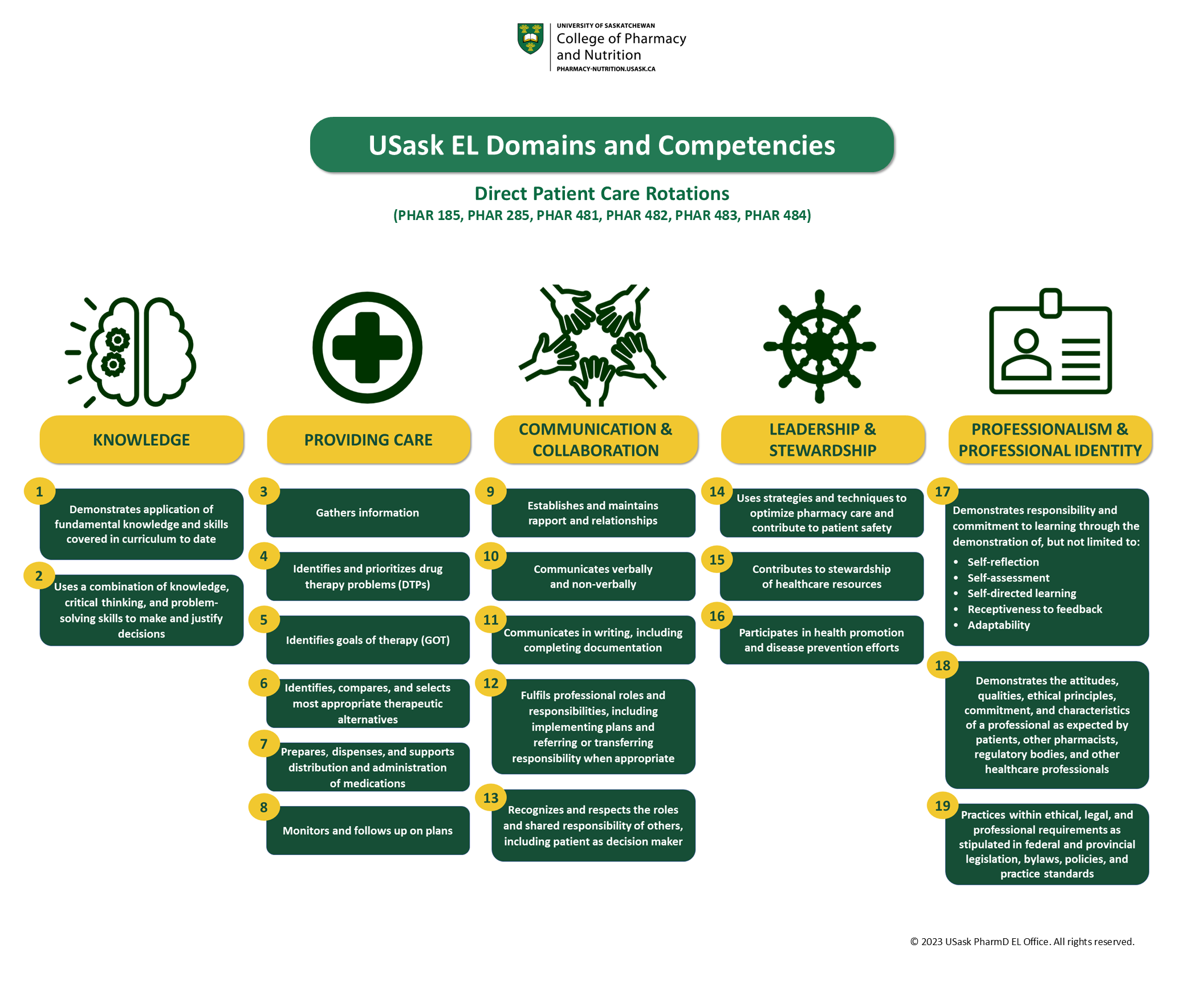
The same 19 USask EL competencies are used to evaluate students in non-direct patient care rotations. Thirteen of the competencies are required and 6 are optional, as applicable to rotation activities.
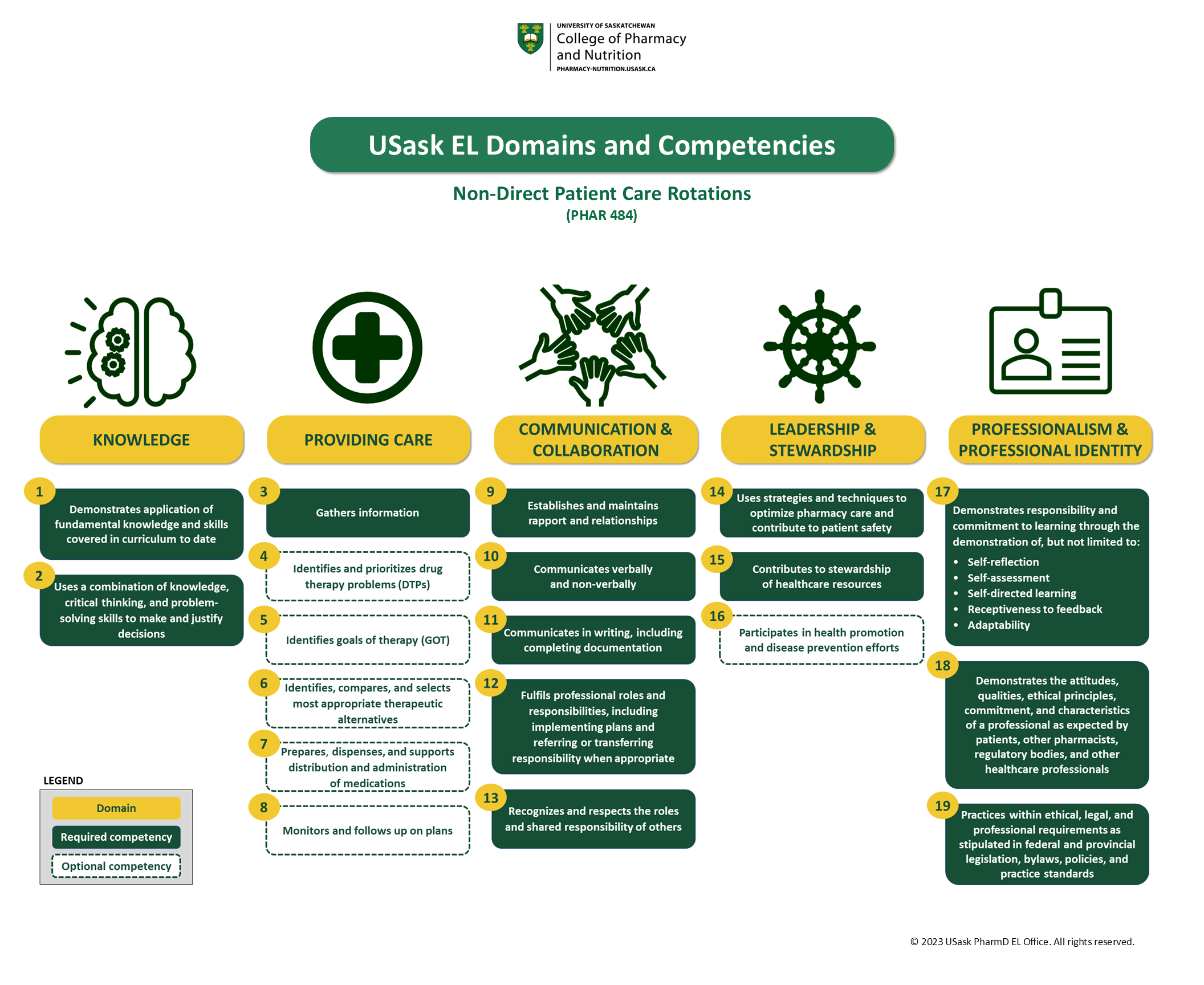
The competencies are written as behaviours because they are meant to be observable. A student must be able to consistently demonstrate the competency under the guidance and appropriate supervision of a preceptor. The student’s documented achievement rating for each competency informs the EL Office and the faculty which of the AFPC Educational Outcomes and NAPRA Professional Competencies the student is achieving, and which they may be having difficulty with.
Example Activities that Demonstrate Each EL Competency
The Midpoint and Final Evaluation Form should mold to any pharmacy practice.
Students should be able to achieve the expected level in each of the required competencies if offered the opportunity to participate in the daily tasks and activities regularly completed on site.
Click one of the buttons below to download a list of example activities, actions, and behaviours that may demonstrate the EL competencies in practice. These lists are non-exhaustive. They are meant to help identify opportunities for assessment and to stimulate ideas for your own unique practice site.
Expected Level of Achievement
Achievement Ratings
Five achievement ratings guide student assessment in the framework: Insufficient, Emerging, Growing, Competent, and Exceeding.
For each of the USask EL competencies, students' performance will be evaluated and assigned an achievement rating on the Midpoint and Final Evaluation form.

Progressive Growth
A student’s ability to demonstrate the knowledge, skills, attitudes, and behaviours of an entry-to-practice pharmacist is expected to develop with time, exposure, and practice as they progress through the PharmD program. Students will develop from Emerging to Growing to Competent as they gain experience in EL rotations, didactic courses, and work experiences outside of school.
It is expected that Year 1 students will likely require significant guidance and will be able to manage lower complexity situations with beginner knowledge and skills. Students in Years 2 and 3 are expected to take more initiative in solving higher complexity problems as they gain experience and confidence. In Year 4, students should be practicing with self-awareness, initiative, applied and connected knowledge, appropriate judgement, and minimal guidance.

Minimum Expectation By Year
In order to pass the rotation, the student must be able to consistently demonstrate performance at the expected level of achievement for each USask EL competency.
- In Year 1, students must achieve Emerging in each competency and overall in the final evaluation.
- In Years 2 and 3, students must achieve Growing in each competency and overall in the final evaluation.
- In Year 4, students must achieve Competent in each competency and overall in the final evaluation of each rotation.
It is great if students can achieve a higher rating than expected, but the minimum expectation is identified as the standard to pass the course.
If a student is demonstrating behaviours consistent with the Insufficient rating at any point, the EL Office should be contacted.

Assessing for Consistent Performance
Accurate assessment of a learner’s performance requires multiple observations over time. For each competency, learners should consistently demonstrate the descriptors associated with the achievement rating assigned.
In other words, learners’ performance should align with the descriptors of the expected level in the rubrics most of the time throughout the assessment period. It is not sufficient for a learner to demonstrate behaviour consistent with the assigned rating sporadically nor only in the final days of the rotation.
If that is the case, the learner likely achieved a lower rating. Preceptors and learners who are unsure how to consider consistency in their evaluations are encouraged to contact the EL Office.
Performance Below the Expected Level
Midpoint Evaluation
Learners may achieve a lower than minimum expected level at the midpoint evaluation as they will have time in the second half of the placement to demonstrate growth and achievement of the minimum expected level.
In this case, the learner must create a plan for how they will achieve the minimum expected level by the final evaluation and discuss it with their preceptor to ensure it is both reasonable and achievable.
If Insufficient in any competency at midpoint or if not on track to achieve the minimum expected level by the final evaluation, students must reach out to the EL Office immediately. Preceptors are also strongly encouraged to reach out. At that point, the EL Office will support both the student and preceptor through the remediation process. See the EL Remediation Handbook for more information.
Final Evaluation
An achievement rating of less than the minimum expected level in any competency by final evaluation will result in unsuccessful completion of the EL rotation and a grade of Fail will be assigned. A learner cannot achieve a higher overall achievement rating than their lowest individual rating in a competency (i.e., if the learner is graded Growing in one or more competencies, they cannot receive Competent overall).Concerns with Student Performance
The algorithm below describes potential outcomes that are possible when concerns are raised about a student's performance or behaviour. Students who are struggling may be offered remediation. Remediation in the context of EL means that the student is offered extra support during the rotation to improve their performance. The EL Office and preceptor(s) support the student in identifying a plan for improvement, which generally involves the creation of an individualized student-driven learning plan. In some cases, such as when the student's performance is putting patients or others at risk, the EL Office may intervene to reassess the suitability of the student remaining at the practice site.
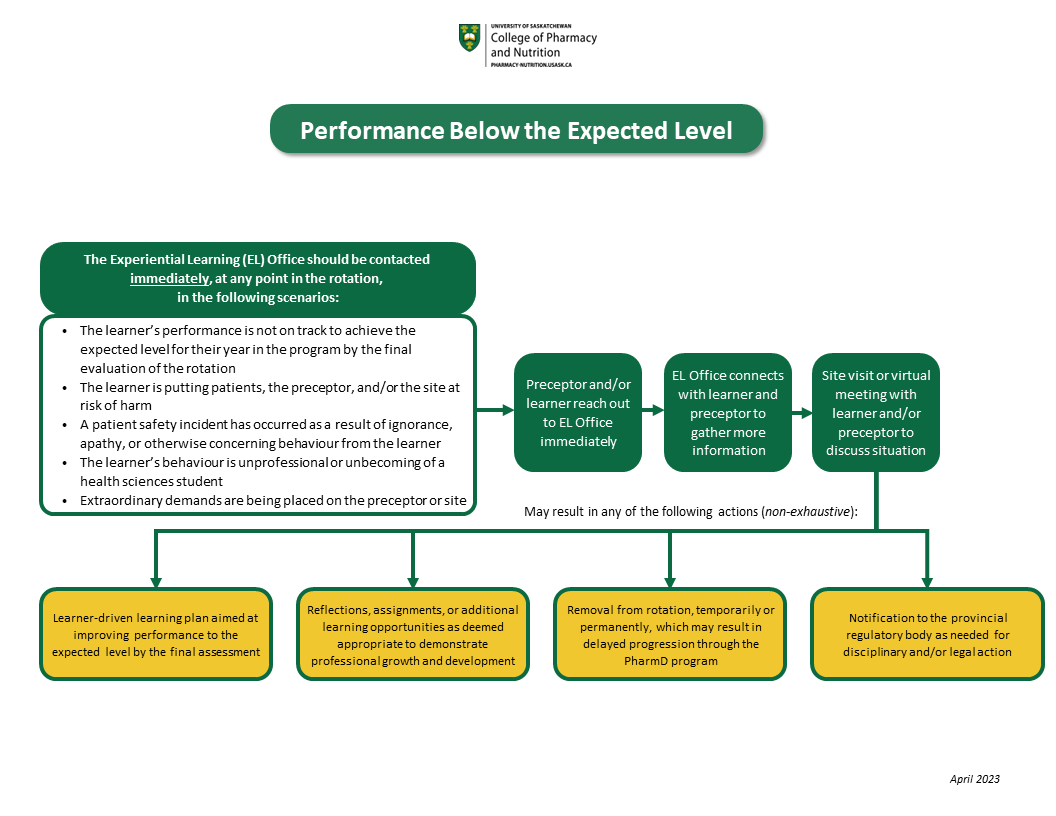
Remediation in EL
Updated August 2023
When students are not meeting expectations in EL, remediation opportunities are often offered to help the student identify why they are having difficulty, what to improve, and how to be successful.
The EL Office encourages students and preceptors to reach out as soon as possible when a student is struggling. Remediation is most successful when implemented early!
Completing Evaluation Forms
Student Self-Evaluations
Students must complete 2 formal self-evaluations in each rotation:
- Midpoint Self-Evaluation
- Final Self-Evaluation
Students complete these self-evaluations electronically using the Midpoint and Final Evaluation Form in CORE and should submit them at least 2 days before the scheduled midpoint and final assessments.
Students are responsible for demonstrating and documenting evidence of achieving the minimum expected level for each EL competency and must also propose how they plan to improve in areas of deficiency.
Preceptors are expected to review the students' self-evaluations at midpoint and final and have a discussion with the student about how their self-evaluation compares to the preceptor's evaluation of their performance.
Preceptors are encouraged to hold students accountable to documenting sufficient evidence in their self-evaluations. If you feel a student needs to revise their self-evaluation, please have them email the EL Office to unlock the form in CORE.
Watch the video below to see how to find and review student self-evaluations.
Preceptor Evaluation of Student
Preceptors are required to complete formal, electronic evaluations in CORE at midpoint and final for each rotation and discuss with the student.
Watch the video below to see how to complete midpoint and final evaluations.

